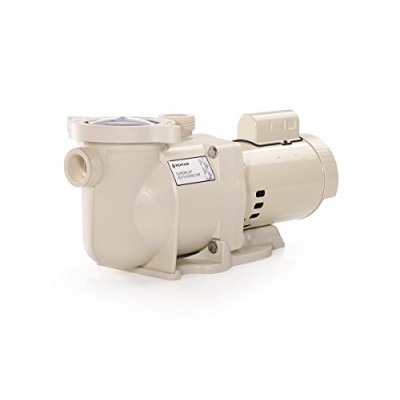Pond Pumps Canada is part of the Amazon Affiliate Network. We may receive payment for items purchased through the Amazon website.
This Pentair SuperFlo High Performance pump is the perfect choice for any pool, spa, or water feature. This is one pump that doesn't suck. It runs efficiently and quietly on 115 or 230 volts and its small footprint allows it to fit in compact spaces. Cleaning and maintenance are made easy with the Cam and Ramp see through lid By running more efficiently and with less effort, the Pentair High Performance pool pump will pay for itself over years of use. Get a commercial grade pump at a consumer price. Keep your clean running as it should be with the Pentair SuperFlo 115/230 Volt Single Speed Swimming Pool Pump.
- The Pentair SuperFlo single-speed, 1-1/2-horsepower pump moves more water more efficiently for lower operating cost
- Quiet operation due to superior internal flow design that reduces hydraulic noise
- Features thick walled body parts, a heavy-duty 56 square flange motor, and highly engineered hydraulics
- Oversized strainer basket extends time between cleanings; see-through lid makes inspection fast and easy
- This pump has self-priming for quick, easy start-up; 1-year warranty
Pentair 340039 Stainless Steel SuperFlo Single-Speed Almod Pool Pump, 1-1/2-Horsepower 115/230-Volt Single-Phase
- Brand: Pentair
- Product Code: 340039
- Availability: In Stock
Dynamic Head
The effect of the Earths gravity on the "lift" or head pressure is fairly simple; for every vertical foot of distance the pump moves the water you are adding one foot of head pressure so the ratio is a 1:1 ratio. The effects of the friction, caused by water as it travels through your hose or pipes, on the total head pressure is a little more difficult to calculate especially as there are slight variations in pipe friction in different hose materials and the smoothness of the inner bore. Basically. for every ten feet of pipe through which the water has to travel travel horizontally will contribute 1 foot of head height; the ratio of the pipe friction loss is a 10:1 ratio.Plumbing fixtures and bends and corners in your hose also increase the total head you must calculate to ensure the proper final volume from your pump. Every corner with a 90 degree elbow in your plumbing will add 1 foot of head pressure with a 1:1 ratio. 45 degree elbows, tees and even insert couplers can all have an impact on the final flow.
If you install a pump 40 feet away from the top of your waterfall which is 6 feet above the pump and the tubing is a single run of 40 feet horizontally then you add 4 feet of head for the tubing length (the 10:1 ratio) to the 6 foot differnetial between the pump location and the final height of the waterfall so your final total dynamic head calculation would be 10 feet. This means your final volume of water flow in this water feature or application would be the volume of flow on the performance curve that equaled the gallons per hour at 16 feet. This volume will certainly be much less than the initial volume the pump can move at an open flow or a zero head.
If in the above example your 40 feet of horizontal tubing run also required 3 elbows of 90 degrees then an additional 3 feet of theoretical head would be added and your final flow result would be at 19 feet on the performance curve of the pump. In this example you would want to choose a pump that has the desired GPH rating at 9 feet of head pressure. Tubing size is also an important factor in accounting for head pressure loss, in general you should never reduce the diameter of the tubing below what the output size of the pump is, this will drastically increase head pressure, and reduce pump performance. For maximum pump performance, using the largest tubing that is practical is the best choice. A best practice is to use a hose with an inner diameter that is the same as your pumps outlet fitting.

